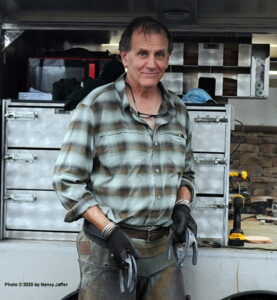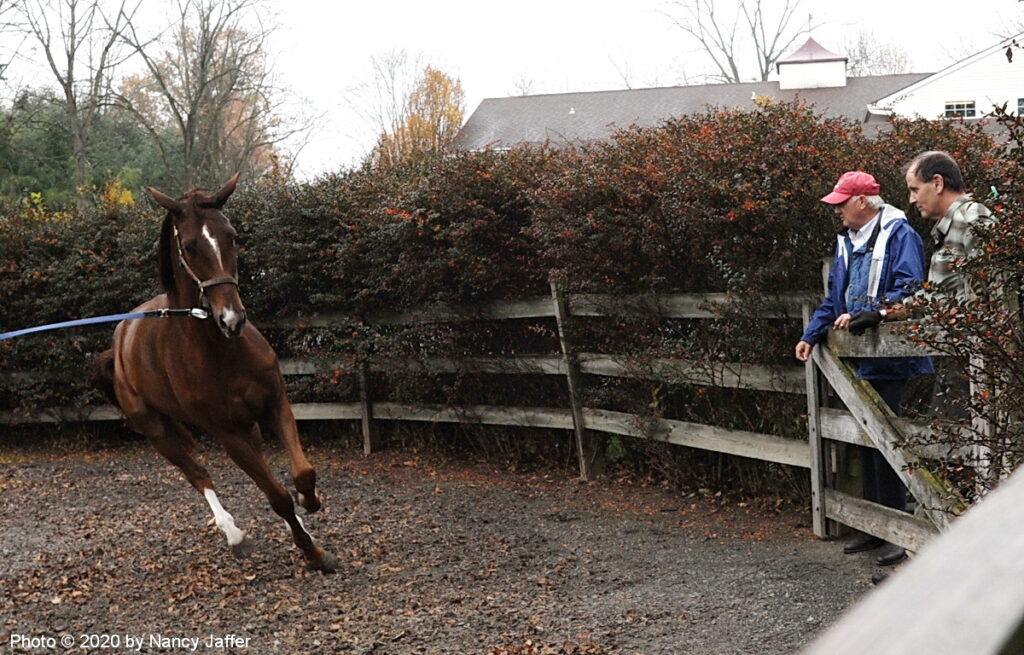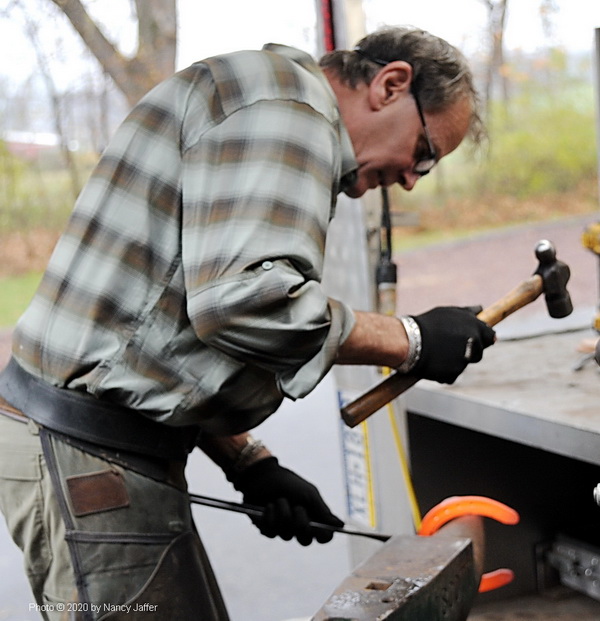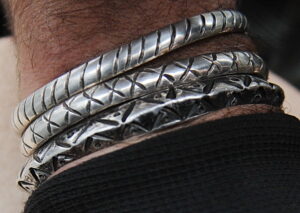It obviously was Steve Teichman’s destiny to become the U.S. eventing team’s farrier.
The career path that made him one of the most respected practitioners of his trade around the world began in an unusual way when he was just 13. Steve’s father came up with what he thought was a bright idea to sidetrack his son’s artistic inclinations, since he preferred the teen to focus on eventually getting a “proper” college degree.
“I know this guy who shoes horses in Delaware. Why don’t you go work with him for a summer? Maybe that will satisfy some of your creative instincts,” Dad slyly suggested.
Turns out he was right–except that it backfired.
“This is where the hand of fate gets involved,” Steve recalled with a smile.
“I did that, and there wasn’t any looking back.” He had found what he was meant to do. Even though Steve went on to get a degree in biology, he was shoeing horses on the side while in college and never stopped.
Steve’s father “wasn’t really happy” with the way his plan turned out, but legions of horse owners, veterinarians and team members over the years have been incredibly grateful that Steve pursued what appears to be his pre-ordained profession, from which he retired this month.

Steve Teichman in a familiar pose with handfuls of shoes by his truck. (Photo © 2020 by Nancy Jaffer)
Jim Wolf, who managed the U.S. eventing teams in the 1990s and into the 21st century, called Steve “just a genius. He’s an artist, an engineer, all those things you need to be a good farrier.
“He’s the whole package and such a great person to have on team trips, such a great influence on everyone about how to be a human being.”
Steve did his utmost to get horses in shape to compete, but he also had the same type of consideration for the horses.
“He could always figure out how to get the horse comfortable,” said Jim, yet at the same time, “If Steve said a horse shouldn’t go (into a competition) then it shouldn’t go.”
Steve’s expertise has been unique.
“What made him so good was in solving a crisis, he was able to see the big picture,” commented Oldwick-based Dr. Brendan Furlong, who served as veterinarian for the eventing team.
“His understanding of micro- and macro-anatomy of the horse’s foot is probably greater than any other person I’ve ever interacted with,” observed Brendan, calling Steve, “an incredibly clever man.”

Brendan Furlong and Steve Teichman have watched many horses go over the years as they blend their expertise to solve problems. (Photo © 2020 by Nancy Jaffer)
He got to know Steve while treating horses ridden by two-time eventing world champion Bruce Davidson. In the early middle 1990s, Brendan recalled, a lot of U.S. riders were training in the United Kingdom, where the Americans were having problems getting farriers who would do things the way they wanted them done. The answer to that was drafting Steve, who began working with the team in 1997.
Here’s a story that demonstrates Steve’s inventiveness. When the team went to the Open European Championships at Burghley, England, that year, one horse had torn off a shoe on cross-country and as the time came for the horse inspection, the competition’s farrier was nowhere to be found. He had the forge, the steel and everything else that Steve needed to use if he were to fix things (he couldn’t transport his own equipment overseas, so he was reliant on the local man’s truck.) Steve came up with an inventive remedy for the bar shoe he lacked–nailing an ordinary shoe on the foot backwards to provide support for the trot-up. The horse passed the ground jury’s scrutiny, Steve finally got access to the truck and was able to produce a regulation bar shoe so the horse could compete in the show jumping phase.
In the days when he worked in the blacksmith shop at the University of Pennsylvania’s New Bolton Center, Steve thought about pursuing a veterinary career, then decided against it.
“I just felt this industry needed the help so badly, I decided to stay with it,” he said.
And that was the way things went until this week, the last time Steve completed his regular shoeing jobs. Although he still will be involved with some consulting, help the industry out with a few clinics and take on a special case here and there, at the age of 62, he decided it was time to step aside from his farrier business.
“Physically, it’s really hard,” he said.
“I don’t want it to get the best of me. It controls your life. It’s hard to take time off with the quality of horses we do.” In a regular (non-Covid) year, he noted, “by now, you would know where you are every single week until April. It’s pretty grueling.”
Yet he still is thinking of the greater good for those who keep on shoeing horses. He spent three and a half years getting a master’s degree in equine locomotion with Britain’s Royal Veterinary College and just finished a 38-page paper on toe surface modifications and how they affect break-over.
“It was really fun to do. I only wish I was 40 years old when I did it,” he said wistfully, “but when it’s published, it will be good to get it into the hands of farriers. This industry needs that.”
While in the last 30 years he thinks there may have been as many as 35,000 peer-reviewed articles in veterinary journals, he estimated there have been only 10 articles on that order for farriers.
The college sent over professors four times a year to meet with students in space provided by the University of Pennsylvania.
“They started this program because they wanted farriers to research and ask questions if they needed answers; vets look at feet differently than a farrier,” he explained.
As difficult as it was to think of retiring from a regular shoeing schedule, Steve pointed out, “There are a lot of other things I really enjoy doing, too.”
He’s had a parallel career producing art and doing silver and metal work, as well as engraving. A gallery or show is his next ambition, and he plans to have a website.
Steve got his training for engraving from men who dealt with firearms. He worked on people’s firearms at his house after getting a federal firearms license. But when he moved to Unionville, Pa., firearms weren’t allowed in a residential neighborhood, so that was the end of that.
“What am I going to do with all these skills,” he wondered, then had his answer in short order.
“It was much more profitable to work on a bracelet, and safer,” he realized.
He’s planning on taking some time to go to Florida with his partner, Laura Rowley, who is an animal communicator and intuitive healer. The two don’t work together, but every once in awhile, her insight will help him out. He recalled being on the phone one day with a client whose horse had a lameness problem, when Laura overheard the conversation and told him, “it’s not in his feet, it’s in his back.”
A good friend of Steve’s is Patrick Reilly, New Bolton Center’s chief of farrier services and director of the applied polymer research laboratory, who also got a diploma in equine locomotor research from the Royal College.
He calls Steve, “The hardest working farrier I know. He’s honest about what he can do and what he can’t. He’s happy to talk to you about it. I would consider him very definitely to be a role model.”
Patrick, who moved to Unionville from New Hampshire, recalled a funny incident when his son, Patrick, came home from the first day of first grade and was very disgruntled.
When his father asked what was wrong, he explained, “I got into an argument after I said my father was the best farrier because he works at New Bolton. And this other kid said, `No, my father’s the best farrier.’” That was Marshall, Steve’s son, and there aren’t many places in the U.S. where two elementary school pupils would have a conversation like that!
Steve’s last turn with the team was the 2019 Pan American Games in Peru, where the U.S. eventers qualified for the Olympics.
“A lot of the team’s medals belong to Steve,” said Jim Wolf.
“We wouldn’t have medaled nearly as many times as we did without Steve. We had gold medal horses and riders, but I have to tell you we had a gold medal backup team and he was a star player.”






